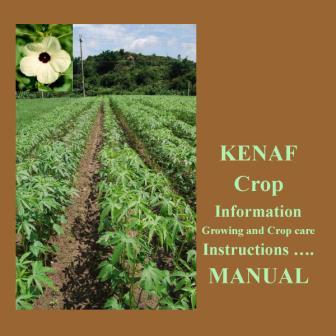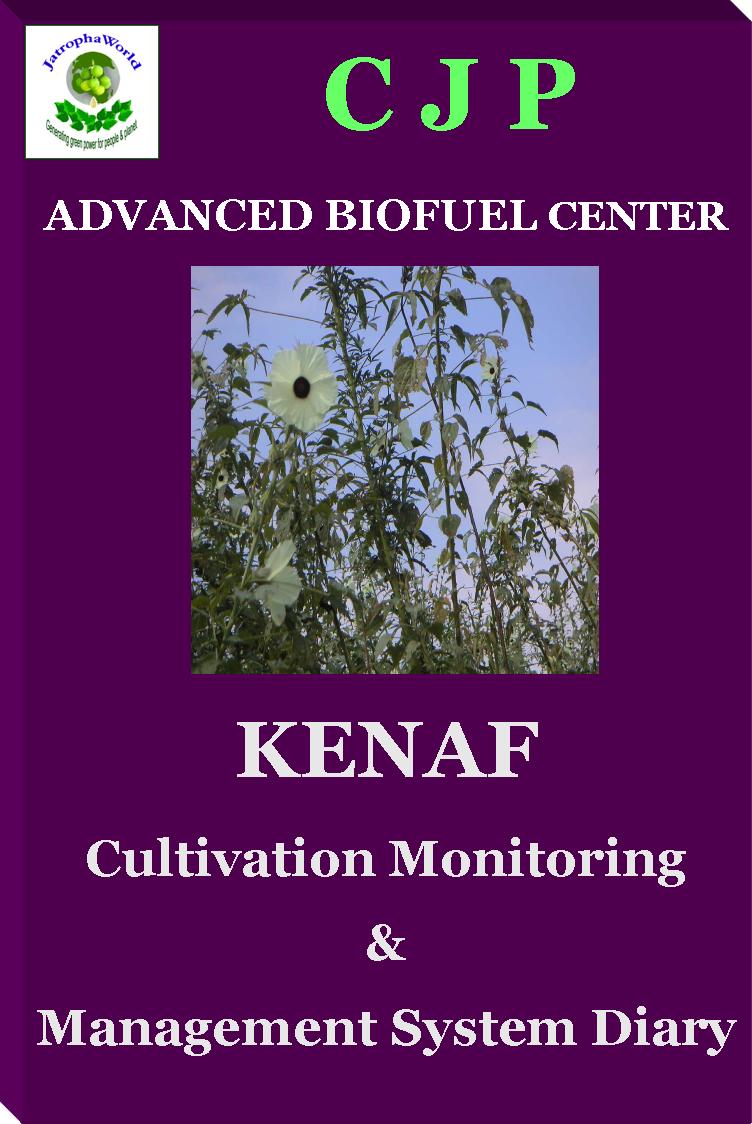 |
|
|||
|
|
| |
 |
KENAF: A NEW SOURCE OF BIODIESELKenaf a fibrous plant that is commercially grown in warm regions for paper production. By making more paper from short rotation fiber crops, more trees can be planted and grown purely for their carbon-sequestering properties. Kenaf also produces an oilseed that has potential for use as a biodiesel feedstock, and the remaining biomass could be used for energy or fuel production. Kenaf hasn't reached its potential as a fiber crop, but shows promise as a high-quality, high-yielding biodiesel crop. KENAF Species: Hibiscus cannabinus, L.Family: Malvaceae , is a warm-season annual fiber crop related to cotton, okra, and hibiscus. The plants, which reach heights of 8 to 20 feet, are harvested for their stalks from which the fiber is extracted. India, Bangladesh, China, Myanmar, Nepal and Thailand are at present the major producers of Kenaf. India, Bangladesh and China are the large producers. The expansion of the commercial industry for kenaf will encompass an understanding of the diverse management systems including the production, harvesting, processing, and marketing kenaf as a fiber, feed, or seed crop, combined with directed research, focused development, and communication among diverse constituencies working closely for economic development. The commercial success of kenaf has important potential economic and environmental benefits in the areas of soil remediation, toxic waste cleanup, removal of oil spills on water, reduced chemical and energy use for paper production, greater recycled paper quality, reduced soil erosion due to wind and water, replacement or reduced use of fiberglass in industrial products, and the increased use of recycled plastics. The activities of private industry augmented by public supported agricultural research continue to provide a diverse range of new kenaf products that suggests a bright future for the continued expansion of kenaf as a commercial biodiesel crop. The plant is said to have been introduced from South Africa and it is grown in India from time immemorial.Kenaf is an important fibre crop in South India. It is cultivated as a rainfed crop in large areas in Madhya Pradesh, Andhra Pradesh and Tamil Nadu. It is sown on the bunds of irrigation channels and in small patches in garden lands. It is stronger than jute, but not so flexible and soft. Our scientists have to introduce and evaluate kenaf as a non-food crop through an integrated approach for alternative land use that will provide diversified opportunities for farmers and biological materials for the “bio-based industries”. Considering kenaf’s potential as an oilseed feedstock for biodiesel, CJP has honor to establish this untapped resource as alternative source for Bio- Diesel industry of future. About the Plant KENAF is the second most important natural fibers next to cotton. Kenaf is a bast fiber crop that has been used for a long time as cordage, ropes, etc. Kenaf, Species: Hibiscus cannabinus, L.Family: Malvaceae , is a warm-season annual fiber crop related to cotton, okra, and hibiscus. The plants, which reach heights of 8 to 20 feet, are harvested for their stalks from which the fiber is extracted. Its coomon names are: English: kenaf , India (Bengal): mesta, Chennai: palungi, Bombay: deccan hemp, Andhra Pradesh: Bimli jute, Taiwan: ambari, Egypt & northern Africa: til, teel, or teal. Indonesia: Java jute, Brazil: papoula de Sao Francisco, South Africa: stokroos and West Africa: dah, gambo, and rama. Grown for thousands of years in Africa where its leaves are consumed in human and animal diets, the bast fiber used for cordage, and the woody core of the stalks burned for fuel; this crop was introduced into southern Asia around 1900. Principal production areas are China and India. BOTANICAL FEATURES
Botany of the Plant The plants are herbaceous annuals; growing to a height of even 5 m. the stems are straight, with small prickles: leaves alternate, stipulate, lobed and with serrated margins,stipules long and pointed: flowers solitary, with short pedicels and axillary, epicalyx stiff, consisting of seven to eight bracteoles: corolla larger, spreading pale yellow or yellow with crimson or purplish centre: stamens numerous on a staminal column: ovary superior, five carpelled: style passes through staminal column and terminate in five stigmatic branches: fruit capsule, five loculed each containing four to five seeds. It is mainly as self-pollinated crop. Leaves. Kenaf plants produce simple leaves with serrated edges on the main stalk (stem) and along the branches. The position of these leaves alternate from side to side on the stalk and branches. Flowers and Pollination: Kenaf plants produce large showy, light yellow, creamy colored flowers that are bell-shaped and widely open The flowers are 8 to 13 cm in diameter with 5 petals and are borne singly in the leaf axis along the stalk and branches. The complete flowers are indeterminate; therefore the plant continues to produce additional flowers. Although the plants are highly self-fertile, generally considered self-pollinated, the plants can be cross-pollinated
Seed and Seed Capsules: Following pollination, a pointed, ovoid, seed capsule is formed that is about 1.9 to 2.5 cm long and 1.3 to 1.9 cm in diameter. The seed capsules are covered with many small, fine, loosely held, hairy structures that are very irritating when in contact with human skin. Each capsule contains 5 segments with a total of 20 to 26 seeds/ capsule. The slate-black, wedge-shaped kenaf seeds are approximately 6 mm long and 4 mm wide, with 35,000 to 40,000 seeds/kg. Once pollinated, the seeds require 4 to 5 weeks to maturation HABITAT & DISTRIBUTION Originated in India and Africa the plant is best grown in tropics and to some extent in sub-tropics. Kenaf grow almost throughout the world both in tropical and temperate areas it is sensitive to frost. In India, kenaf is grown often as a border crop in garden areas where the soil is loamy and affords good drainage. It is grown mixed with most cereals in dry lands or as a pure crop. Kenaf is an important fibre crop in South India. It is cultivated as a rainfed crop in large areas in Madhya Pradesh, Andhra Pradesh and Tamil Nadu. It is sown on the bunds of irrigation channels and in small patches in garden lands. Climate Kenaf cultivation requires specific climate and land. It requires early rains in March, May and June and intermittent rain and sunlight thereafter till August, temperature between 28°C and 35°C and humidity between 70% and 90%. This type of climate is available in areas between 30° Latitude North and South of the earth. Soil One of kenaf’s advantages as a crop, is it can be successfully grown in a wide range of soil types, from high organic peat soils to sandy desert soils. Although kenaf grows better on well-drained, fertile soils with a neutral pH, the crop can withstand late season flooding, low soil fertility, and a wide range of soil pH values. Kenaf also has shown excellent tolerance to drought conditions. CULTIVATION TECHNOLOGY The productive cultivation of Kenaf needs to be scientifically managed for better growth and production. The growth and yield of the plant could be improved through effective management practices. The enhanced cultivation technology and improved inputs developed by CJP may provide plenty of biodiesel without displacing food crop and without utilizing prime food land in terms of sustainable farming techniques The key factors that can influence the oil yield of Kenaf are:
CJP carefully manages Kenaf cultivation, with advanced crop practices suitable to local soil, weather, pest, and disease conditions to ensure the high amount of oil as we have developed enhanced technology with regards to:-
The key factors governing profitability of large scale production are:
CJP’s Researchers have developed standardized techniques for growing Kenaf on large scale. CJP ensures Organic Kenaf cultivation right from the land preparation, crop management to production of end product. CJP Kenaf Farms are under the vigilant supervision of agronomists, who make sure that the latest and best breed of Kenaf is being planted. However, we keep a close watch on the research results of Kenaf breeding by studying thousands of Kenaf variants, identifying and collecting the best sources of high-quality to guarantee a consistently high yield. Accordingly, the enhanced variety of with regards to seed yield and oil yield and the enhanced Cultivation techniques may ensure proper and profitable production of THE OIL CROP providing early fruition and flowering—CJP's “Kenaf Cultivation Technology” is available at an affordable Price Kenaf Crop Information Growing & Care Instruction Manual and Monitoring & management system
As all biological organisms require care and attention, the need to draw Growing Instructions was being felt by all concerned Therefore keeping in view Various concerns and problems of a new Grower; CJP being “The Centre of Excellence” has designed Kenaf Growing & Care Instructions Manual with Monitoring & Management System Diary on the basis of our own tried, tested, developed and experienced Plant Propagation and Cultivation Technologies and Practices to help you grow a Failsafe Kenaf Fuel Farm The Kenaf Growing & Care Instructions manual provides basic guidance for the project developers to help ensure successful Kenaf cultivation projects. Proper planning, cultivation and maintenance are the key for growing flourishing plants. Simply putting a plant in the ground is not enough. Careful thought must be given to the purpose of the cultivation, location of the cultivation and how the Kenaf will be cared for once they are in the ground. A properly planted and maintained plant will grow faster and live longer than one that is incorrectly planted. This booklet is organized as a step-by-step checklist of fundamentals to help you with your Kenaf cultivation project We have sincerely tried to put all steps in nutshell and hope it will be a useful tool in growing your Biodiesel Plantation Both the Kenaf publications are available Order Just Know Agricultural Extension Kit CJP has specifically developed and designed a unique kit for Kenaf plantation and crop care for 1 hectare called: “Agricultural Extension Kit” – a key to your fuel farm “just enables & encourages the farmers/ new growers to start the Biodiesel crop cultivation in a right and prefect manner by adopting the concept of “sustainable agriculture”. Kenaf Starter Kit: Kenaf Agri- Extension Kit contains 1. SRIPHL K03 Elite cultivation stock for cultivation in 1 ha 2. an easy- to- follow growing and crop care instructions manual 3. a very typical monitoring and management diary Order Just Know Kenaf HYV Elite Seeds
TERMS & CONDITIONS Packing: 2,10,20,50 KG Bags Shipment: FOB/CIF Minimum QUANTITY: 3.0 tons by sea, 2 kg by air PRICE: quote? Working time: 30 days After Payment ALL PAYMENT TERM:100 % Advance Phyto sanitary charge: included
Order Just Know Economic Evaluation of Kenaf Kenaf is an annual fiber crop of great interest for both the production of industrial raw materials and as bio-fuel. The main reasons for considering kenaf as a high productivity multi-purpose non-food of increasing importance are listed below: Ø It is a multi-purpose crop and can provide raw material for industrial and energy applications. Ø The 30-40% of the stem (bark) can be used for several high value fibre applications while the 60-70% of the stem (core) among several industrial applications can be used for thermo chemical process (combustion pyrolysis and gasification). Ø The high biomass potential and the low inputs of the crop. Dry matter yields came up to 26 has been reported Ø Under the semi-arid conditions, it requires 250-400 mm of water, which is much lower than in conventional land use largely reassembly cotton in water requirements. Ø On the other hand, considering the low N requirements (50-100 kg N/ha), this crop is believed comprising an important alternative land use in lands with poor and moderate water availability. Ø It offers alternative land use and can be used in a crop rotation. Kenaf can be cultivated in rotation system. This is very important in areas devoted to monocultures (cotton, cereals) Ø As an annual crop can be used where crop rotation is indispensable due to local crop disease, weed competition or soil fertility degradation. High farmer’s perception. Being an annual crop, kenaf does not require a long-term commitment in land use Although kenaf is being cultivated worldwide mainly for fiber production CJP is aiming at addressing the sustainable yielding potential, the alternative industrial bio-products as well as the fuel quality of kenaf as a non-food crop, under certain cultivation techniques. At CJP, we are making all sorts of efforts to introduce and evaluate kenaf as a non-food crop through an integrated approach for alternative land use that will provide diversified opportunities for farmers and biological materials for the “bio-based industries” of the future. We have determined the sustainable yielding potential of kenaf, as a non-food crop and have evaluated the effect of harvest timing and storage methods on quality of raw material. We have evaluated the suitability of kenaf both for selected industrial and energy applications.
The production and management systems are being developed for agricultural annual non-food crops, bringing thus costs of delivery down to commercially accepted levels. A Feasibility study is required to be carry out Þ To conduct an economic evaluation of the whole production chain of the crop for alternative land use. Þ Economic analysis for the crop production chain (Cost of kenaf at farm and at plant gate (including harvesting, storage and transportation). Þ Economic comparison of kenaf with other annual conventional crops. We perform/provide the prefeasibility study report at affordable cost KENAF BUSINESS PLANSample/ Ready Built Business Plans Sample/ready built Biodiesel business plans are drawn in universal scenario based on optimum conditions for growing the biodiesel crop worldwide and on crop specific science, agronomy and economy in wider context Sample/readymade business plan are available for 20 hectare, 100 hectare and 500 hectare as per details on page http://www.jatrophaworld.org/biodiesel_business_plan_95.html Kenaf Feasibility Study Report We recommend carrying out Feasibility Study Report for project size of 5000 hectares or more to determine the land identification and suitability of growing the Kenaf Customized, Complete & Comprehensive Kenaf Business Plan
· Income Statement · Balance Sheet · Capital Budget · Cash Flow · Break-even Analysis · Sensitivity Analysis · Assumptions Governing the Projections These projections will be valuable in determining feasibility of the project, securing financing, attracting investment and guiding management so that the company can reach its full potential.
For a detailed quote for a complete and comprehensive Kenaf Biodiesel Business Plan from Farming to fuel, kindly mail to jatrophaplan@gmail.com or contact Assistant Director, CJPTele: +91-9413334600 |
||||||||||||||||||||||||||||||||||||||||||
© 2004- 2025 ABC-Advanced Biofuel center ,, All Rights Reserved |


 The cultivation, looking after and harvesting
plants is an important factor and it requires a lot of knowledge, skill and
techniques viz: the best cultivation season to make the plant early matured,
then an amount of seeds to be planted, an irrigation & fertilization
method, a control method of weeds , investigate quality, yield, and degree of
occurrence of several troubles .
The cultivation, looking after and harvesting
plants is an important factor and it requires a lot of knowledge, skill and
techniques viz: the best cultivation season to make the plant early matured,
then an amount of seeds to be planted, an irrigation & fertilization
method, a control method of weeds , investigate quality, yield, and degree of
occurrence of several troubles . CJP can help clients
identify the needs, opportunities and solutions of their local, regional and
national markets. By identifying these needs and providing management
direction, CJP can help in creating a perfect business plan in order to develop
and manage an effective and successful biodiesel facility. The most critical
component of any business plan is the pro forma, an educated view or projection
of what the performance of a company is capable of, given a specific set of
assumptions and conditions. CJP has been involved in identifying these needs
for specific projects for a number of years and can help develop a realistic
and obtainable:
CJP can help clients
identify the needs, opportunities and solutions of their local, regional and
national markets. By identifying these needs and providing management
direction, CJP can help in creating a perfect business plan in order to develop
and manage an effective and successful biodiesel facility. The most critical
component of any business plan is the pro forma, an educated view or projection
of what the performance of a company is capable of, given a specific set of
assumptions and conditions. CJP has been involved in identifying these needs
for specific projects for a number of years and can help develop a realistic
and obtainable: